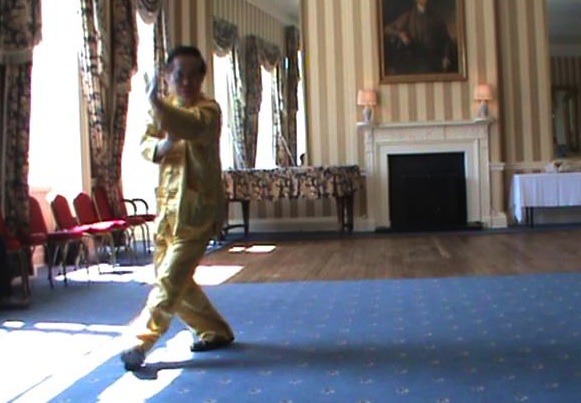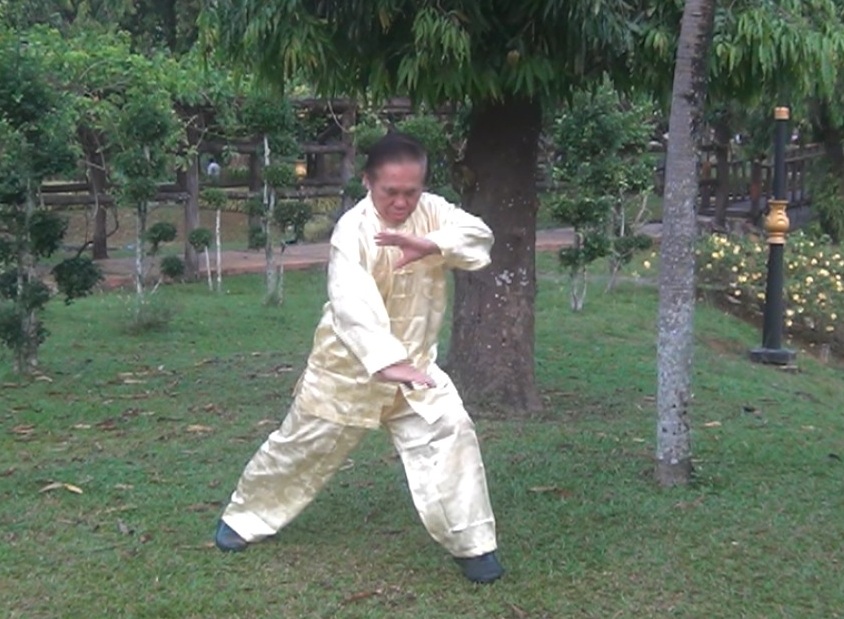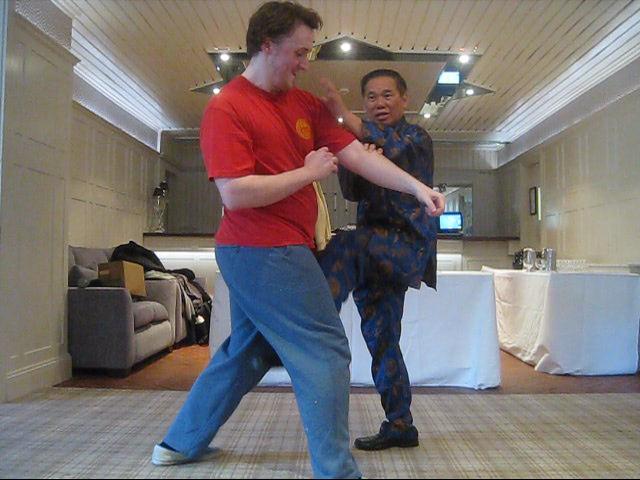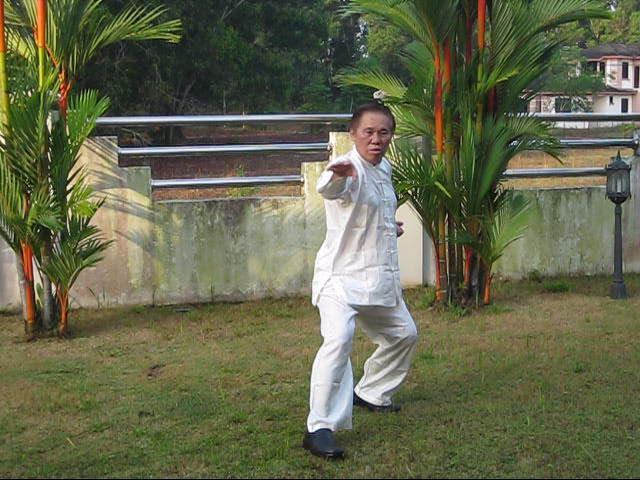SELECTION OF QUESTIONS AND ANSWERS
NOVEMBER 2014 PART 3

Baguazhang
Question 1
I have had many repeated events that I find a little disturbing. Can training Baguazhang lead to "disappearing" from people's awareness?
Without meaning to, I seem to disappear from people's awareness, even when I am standing in front of them or they are speaking to me!
I have had conversations with my friends when suddenly their voices trailed off and they seemed to forget I was right there in front of them.
Other times, I was speaking with people and then I was interrupted by someone cutting across my voice. They did not seem malicious or disrespectful; It was as though they did not know I was there.
In fact, a few times people literally walked through the space where I was standing; they did not see me at all or even notice me until they bounced off of me!
One time, when I was speaking to a group of about ten people, one person suddenly stood up right in front of me to address the group that I was addressing, even though I was still talking. The other people immediately forgot about me as though I had never been there, despite the fact that they were looking right at me until the other person blocked their view of me.
I made a brief perusal of my kung fu, especially Baguazhang, literature, and one book mentioned that some Baguazhang masters claimed to be able to manipulate their opponents' awareness to create "gaps" through which they slipped in to escape and strike their opponents down from their sides or back. While that certainly sounds like a useful ability, it is not necessarily one that I find useful at this point in my life. In fact, I may very well need its opposite, the ability to command attention, not lose it.
Some times I find vanishing from people's awareness amusing and useful, especially when I wish to extricate myself from awkward social situations, but I find it frustrating more often than not. I have never made any attempt to "become invisible", and what bothers and frustrates me the most is that after I graduate and become a medical doctor, I am going to need a far more powerful presence to command respect and action.
For the moment, I've set aside Baguazhang training and am currently practicing Two Finger Zen in the mornings and Golden Bridge in the evenings, as well as some sets and sequences from the basic Shaolin syllabus. Occasionally for fun I practice Cross-Road at Four Gates or the Taming the Tiger set. These arts and sets make me feel more "solid" and "real" whereas the Baguazhang training makes me feel more "insubstantial" and "invisible."
Baguazhang indeed made me feel very powerful, agile, fast, and happy, but I was a little worried about this "invisibility" getting in the way of my professional development and helping people in the future without having a sure idea of how to not disappear from people's awareness.
Would Sigung have any advice about how I can prevent myself from inadvertently "disappearing" from people's awareness? Is vanishing from people's awareness an expected result of Baguazhang training?
— Frederick, USA
Answer
Your experience with Baguazhang is really interesting. I haven't come across cases like yours, nor explanation that Baguazhang could make its practitioners disappear. But I know for a fact that Taoist cultivation can have this ability of not being visible to other people when desired.
I believe my sifu, Sifu Ho Fatt Nam, who was also a great Taoist master, had this ability. I suspect that I might also have this ability though I did not learn it formally, and did not use it consciously. On some occasions, I just walked past checkpoints as if the guards never noticed me.
I might have developed this ability unknowingly through my training. This, actually, is not uncommon in our school. I have often mentioned that our instructors and senior students are capable of abilities that they themselves might not be aware of. It is of utmost importance that we must never abuse this ability. We must always use it for good.
This disappearing ability is very useful, and it also manifests a rare and special skill in the arts taught in our school. I would like you to develop and master it. In fact I would like you to specialize in Baguazhang and one day teach it in our school. It is a wonderful art, and you have made great progress in it, more than many practitioners who have practiced Baguazhang for years. We would like Baguazhang to flourish in our school.
To master a skill means to have full control over it. It means that you can choose to disappear or be assertive depending on your will. It is very simple for us who are well trained in the arts of our school. It is difficult or impossible to other people.
(Editorial Note: Grandmaster Wong explains the method but it is not revealed here in public.)
The sets you mentioned are assertive. Probably the most assertive is Iron Wire.
If all other things were equal, certain sets are more cost-effective to produce elusive effects, and other sets assertive effects. Baguazhang is probably the most elusive, and Iron Wire the most assertive.
Question 2
Must we go through the process of standing still, relaxing our body and concentrating in our breathing every time before we proceed with the "Butterfly" and "Bear Walk" exercises? And how long should we stay in the relaxing part?
— Stephen, Malaysia
Answer
Yes, it is very helpful to stand still and be relaxed before proceeding with the "Dancing Butterfly" and "Bear Walk" exercises. You need not worry about your breathing, but let it be natural. Stay in this standing upright and relaxed position for about a minute or two.
At the end of the practice session, it is also beneficial to stand in this upright and relaxed position for a minute or two.

Taming the Tiger
Question 3
In the "Bear Walk" stance, I observed that both your feet were quite parallel to each other while being about shoulder's width apart. Must they be parallel? You see, generally while standing with feet apart we feel more comfortable with our feet in a slight "V" formation which is more natural because of our skeletal structure.
I felt some muscle strain on the lower part of my legs from below the knees down at the sides when I maintained the formation of my feet parallel to each other. (Of course, in time to come those muscles will get used to it.) But is that the correct way, forcing the natural into the unnatural? Do we still get optimal benefit because we do not feel comfortable to concentrate fully in the exercise?
Answer
The natural position while standing upright is to have the feet parallel. But many people stand with their feet in a V position, and they become used to it.
If you stand in a V position you have to tense your leg muscles to keep yourself upright. If you relax totally you will fall backward. But you have been so used to this position and the tension that you may not realize that you are tensed. When you are tensed you may not generate an energy flow.
But if you keep you feet parallel, you can relax fully without falling. Even without perform "Dancing Buttery", "Bear Walk" or any other chi kung exercise, you may feel your chi or energy flowing. If you let go you can follow the energy flow. Untrained people, however, tense their leg muscles further as they mistakenly think that they lose balance and thus stop the energy flow.
So when you feel your energy moving you, don't tense any muscles. This is a very common mistake amongst beginners. Just let go and follow the flow, and you will find it not only beneficial but also pleasant. We get optimal benefit when we are comfortable.
You felt some muscle strain on the lower part of your legs when you stood with your feet parallel to each other because you are used to standing in a V position and its resultant tension. The tension has become habitual that you do not realize it. Just as some people are sick and in pain so regularly that they mistakenly think that to be sick is natural. No, sickness is not natural. It is natural to be healthy.
Similarly standing upright with feet parallel is natural. You may need some conscious effort initially to undo your bad habit of standing in a V position, but soon you will find it natural and comfortable to stand upright and relaxed with your feet parallel, just as sick people have to spend some time to overcome their sickness and soon realize that to be healthy is natural and joyful.
Question 4
You recommended your exercise twice a day, morning and night. Must it always be on an empty stomach? If not, how long should one wait after meals?
Answer
Most chi kung exercises require a practitioner to have a gap of about half an hour before or after meal. But in our case, it does not matter. In other words, you can have your breakfast or any meal before or after the exercise. You can also practice without taking any meals.
In many schools, students have to wait for some time before or after a meal before they practice because the food in their stomach may interfere with their chi flow. In our case, our chi flow is powerful, so we have the luxury of not worrying about waiting before or after meals.

Shaolin Kungfu
Question 5
I was wondering why there was a lot of hate and talking down of Shaolin martial arts from the UFC/MMA community in the West.
— Danny, USA
Answer
There are two main reasons why the UFC/MMA community mock at Shaolin martial arts.
Firstly, the UFC/MMA community and genuine Shaolin martial artists have opposite philosophies. UFC/MMA practitioners glamorize fighting, sometimes to the extent of neglecting their health and well-being. In other words, they love to fight and want to win, even if winning may cause them more injuries than losing.
On the other hand, genuine Shaolin martial artists, who are very rare today, do not love fighting. They prefer not to fight if they can, but if they have to fight, they can fight well. In a fight, the first principle of genuine Shaolin martial artists is safety first. In other words, they prefer losing a fight by remaining unhurt to winning a fight but injured.
As there is a choice, genuine Shaolin martial artists would not fight even when UFC/MMA practitioners mock them.
For the purpose of academic discussion, suppose there were no choice and a UFC/MMA practitioner and a genuine Shaolin master had a fight, who would win. I would say the genuine Shaolin master would win, but he might have to seriously injure or even kill the opponent, something that he would prefer not to do.
The second reason is that as genuine Shaolin martial artists are very rare, most of those who practice Shaolin martial arts cannot fight and do not have internal force. UFC/MMA practitioners, who glamorize fight, despise them, not knowing that these people do not practice genuine Shaolin martial arts.
What do we mean by genuine Shaolin martial arts? We mean that Shaolin martial arts that are effective for fighting, develop internal force, and promote spiritual cultivation. Martial arts that do not have one or more of these factors, even when their practitioners perform Shaolin forms, can't be called genuine.
Question 6
Is Goju Sanchin similar to White Crane Sanchin? Does White Crane come from Fujian?
I am studying Shorin Ryu, Goju Ryu, and Wadokai methods.
I find that using your training methods is also very useful in Karate.
Answer
Yes, the Sanchin kata in many styles of Karate came from the San Zhan (sometimes called Sanchin) of Wuzuquan, or Five-Ancestor Kungfu, which included White Crane.
There is, however, a big difference between Sanchin practiced in Karate, and San Zhan practiced in Wuzuquzn. In Karate there is much muscular tension, whereas in Wuzuquan there is totally no muscular tension.
Yes, White Crane came from Fujian. It was a very widely practiced style of kungfu in that province.
Thank you for your kind comment.

Wuzuquan
Question 7
I started to look deeper into qin-na and I noticed that often the fight was over by the time an opponent hit the ground. Qin-na also offers ways of combating different holds and techniques.
If qin-na can be found in the Five Animals, is the snake much of a grabbing creature or just a wrapping creature? The snake wraps the body around branches and things, but if I further wrap a second or third time I can apply a qin-na method.
Answer
Shaolin qin-na is very sophisticated. There are three main ways of damaging an opponent -- separating tendons, dislocating joints, and gripping energy points.
All these ways are combat ending. When a Shaolin qin-na master separates his opponent's tendons, dislocates his joints or grips his energy points, even if the master lets go the opponent after he has applied these techniques, the opponent cannot fight further.
The Snake style is mainly used for wrapping, as well as going over an opponent's arm to strike him, or wriggling away to escape an opponent's grip. It is rarely used for grabbing, although a master of a snake style may use it for expedient needs.
The kungfu style that uses grabbing is Eagle Claw, and the style that uses gripping is Tiger Claw. There is a qualitative difference between grabbing in Eagle Claw and gripping in Tiger Claw.
Eagle Claw grabbing is supportive. It immobilizes an opponent so that an exponent can finish him with a decisive strike. Tiger Claw gripping by itself is combat ending. A follow-up finishing strike is not necessary.
Question 8
The Crane doesn't always peck. I can alter techniques to further develop options.
Answer
White Crane Kungfu and Wuzuquan do not use pecking. They are regarded as Crane styles not because of their crane beak which may be associated with pecking, but because of their general movements, especially those of their arms.
Another kungfu style that is regarded as a Crane style is Lama Kungfu from Tibet. The swinging arms of a Lama Kungfu practitioner resemble the wings of a crane. Lama Kungfu spread to China as Hap Ka Kungfu, or Kungfu of Knights.
White Crane Kungfu and Wuzuquan use grapping quite often. It is executed with the thumb as one unit and the four other fingers collectively as the other unit. An opponent's arm is grabbed between the thumb and the other four fingers.
The grabbing is quite loose, looser than in Eagle Claw, to "tame" or control an opponent while the exponent executes his decisive strike with the other hand. If we take the three main methods of holding an opponent's arm in ascending order, they will be the catch-hand of White Crane Kungfu and Wuzuquan for taming an opponent, the grabbing of Eagle Claw to immobilize an opponent, and the gripping of Tiger Claw to stop the energy flow of an opponent.
The crane beak, which is formed by holding the five fingers together, is found in Southern Shaolin. It is widely mistaken to be a hand-form to peck or poke at an opponent's vital point, like the eye or an energy point. No, it isn't. For this function, the finger of the Praying Mantis hook-hand, the fingers of a snake-palm or the knuckle of a phoenix-eye fist is more effective.
The crane beak has very specialized functions. It is used only at three places -- the eye, the throat and the groin. It is implemented firstly not with the fingers closed together, but with the fingers open like the open mouth of a crane beak as it aims at its target, grip the target with the fingers close, then pull out an eye-ball, Adam's apple or a testicle. It is a very cruel technique not suitable in today's world.
The five fingers closed together like a crane beak is also used in Northern Shaolin, and is called a hook-hand, but it is different from the Praying Mantis hook hand. It is used to hook an opponent's leg when he kicks.
You can modify your crane beak for grabbing or other options, but it will be more cost-effective if you use the appropriate hand-forms already developed by past masters for their particular purposes. For example, if you want to control an opponent, you use the catch-hand of White Crane Kungfu; if you wish to grab an opponent to immobilize him, you use Eagle Claw; if you wish to be combat ending by gripping his energy point, you use Tiger Claw.
Question 9
When you were studying Kung Fu as a beginner, how did you approach forms? Did your teacher tell you everything or did he leave you some stuff to find out on your own?
Answer
When I first learned kungfu as a beginner from my beloved teacher, Uncle Righteousness, I did not have the understanding and opportunities my students now have. I did not understand, for example, why or how the forms were used, and I did not have the opportunities dictated by the culture of that time to ask questions.
My teacher taught me and all other students without telling us about the forms. I found out their functions and other information much later.
LINKS
Selected Reading
- Low and High Levels; Skills and Techniques
- The Joy of Being with Others
- Even if You Were Weaker
- Choy-Li-Fatt against Boxing
- The Mechanics of Planting Willow
